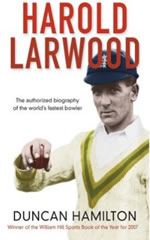Harold Larwood – The Authorised Biography
Martin Chandler |Published: 2009
Pages: 388
Author: Hamilton, Duncan
Publisher: Quercus
Rating: 4 stars

The story of Harold Larwood is well known. An unassuming and very private man Larwood emerged from the Nottinghamshire coalfields in the 1920’s and went on to become the greatest fast bowler, certainly of his generation, and, so some would argue, of any generation.
Larwood was one of the main protagonists in the famous Bodyline Series of 1932/33, the story of which has been published many times in the ensuing three quarters of a century, including in a volume of autobiography published by Larwood himself in the 1960’s.
That Larwood found public life uncomfortable is clear not only from the various books on the Bodyline series, his own included, but also from the biographies and autobiographies of his contemporaries. Very wisely Duncan Hamilton has concentrated in this work on portraying Larwood the man rather than Larwood the cricketer and while there is a statistical appendix to the book this work is not, thankfully, a season by season analysis of Larwood’s deeds on the cricket field.
Larwood himself died in 1995 and Hamilton never had the opportunity to speak to him for the purpose of writing the book but what he has done is spoken to Larwood’s five daughters, as well as other family members and contemporaries. This is not a book that could have been written in Larwood’s lifetime – his modesty and desire to avoid publicity would have ensured that little of the frankness contained in this account would have emerged.
The picture that emerges from Hamilton’s researches is a vivid and moving portrayal of a true working class hero. The story of the shabby way in which his cricketing employers treated Larwood has been told before but only here do we see for the first time the extent to which Larwood was affected by that poor management, by his less than successful post cricketing activities, and, more happily, the pleasure he gained in later life, once he had emigrated to Australia, from his reemergence as a cricketing icon.
The healing of the rifts caused by Bodyline is well documented save for what seems to have been a lifelong, and rather out of character, antipathy towards Sir Donald Bradman. The book gives the impression that this feeling was shared by Bradman although the one photograph here of the pair in later life appears to show a relaxed Bradman in the company of a rather less comfortable Larwood.
Overall this book is a fitting tribute to Harold Larwood. It is well written, meticulously researched and the author’s empathy with his subject shines through. I might have considered giving a five star rating had it not been for the photographs. Cricket books, as with most non fiction books, normally carry their illustrations on art paper in one or more separate sections. In this book the photographs are reproduced within the text and while that means they do appear in context the consequent lack of quality is disappointing.






Leave a comment